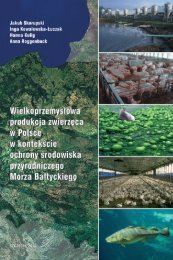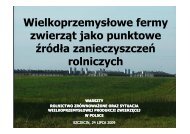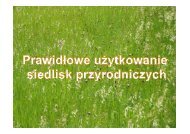best available technologies for manure treatment - Baltic Green Belt
best available technologies for manure treatment - Baltic Green Belt
best available technologies for manure treatment - Baltic Green Belt
Create successful ePaper yourself
Turn your PDF publications into a flip-book with our unique Google optimized e-Paper software.
Best Available Technologies <strong>for</strong> <strong>manure</strong> <strong>treatment</strong> baltic sea 2020<br />
Best Available Technologies <strong>for</strong> <strong>manure</strong> <strong>treatment</strong> baltic sea 2020<br />
ANNEX E: TABLES WITH SHORT DESPRIPTION OF LIVESTOCK MANURE TREATMENT TECHNOLOGIES<br />
Best Available Techniques <strong>for</strong> <strong>manure</strong> <strong>treatment</strong> - <strong>for</strong> intensive rearing of pigs in <strong>Baltic</strong> Sea Region EU Member States Technical Report "Best Practice Manure Handling, Phase 2"<br />
Ref No. 112 P-index<br />
Brief description Description of the effect on leaching (positive or negative) of N and P<br />
The purpose of a P index is to assess the risk of P delivery to surface waters. The index<br />
is a tool to help conservation planners, landowners/land users and others to evaluate<br />
the current risk from P reaching surface water from a specific site, and to determine<br />
factors which dominate the risk due to P transport to surface waters. It will also assist<br />
landowners/land users in making management decisions to reduce the risk.<br />
The P-index has an erosion component, which considers shell and rill erosion, P<br />
enrichment, total soil P, filter strip, sediment delivery, distance to a stream, and the<br />
long term biotic availability of particulate P in surface water ecosystems. . A runoff<br />
component considers water run-off based on a modification of the runoff curve<br />
number, soil tests, rate time and method of P application. An internal drainage<br />
component considers the presence of tiles, water flow to tile lines, surface water<br />
recharge to subsurface flow, and soil tests.<br />
The P-index is a tool, that directly can assess the risk of P leaching, and there<strong>for</strong>e<br />
whether there is a need <strong>for</strong> not spreading livestock <strong>manure</strong> on a certain field.<br />
Establishing of non-cultivated buffer zones along streams, and terraces in the steep<br />
fields, would dramatically reduce the P-index.<br />
The whole index is a <strong>for</strong>mula, which is easily calculated annually once the specific<br />
parameters <strong>for</strong> the given field have been determined.<br />
Research<br />
Pilot<br />
Practice <br />
Innovation stage<br />
Investment price, <br />
Basic Variable<br />
Operational<br />
costs,<br />
per tonnes<br />
Low Low Low<br />
per kg<br />
saved N or P<br />
leaching<br />
Complexity of<br />
implementation<br />
Major references<br />
1: Mallarino et al., 2005<br />
2: Natural Resources Conservation Services (NRCS), 2004<br />
Condition <strong>for</strong><br />
leaching<br />
reduction effect<br />
High P-index<br />
levels<br />
Certainty of in<strong>for</strong>mation<br />
Prices High<br />
Effect on<br />
leaching<br />
High<br />
Low Low<br />
82<br />
Side 84<br />
82








